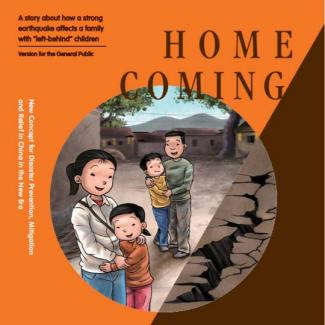
Creating an earthquake scenario in China: A case study in Weinan City, Shaanxi province
INASP’s John Young was part of a piece of work while at ODI, with partners in the UK, US and China, to develop a scenario and communications materials to help local agencies in two districts in China to communicate earthquake risk to local decision makers and the public. A new paper (DOI: 10.1016/j.ijdrr.2019.101305) describes the work. The accepted manuscript is shared here.
Abstract:
In efforts to address government-identified gaps between top-down policies and local-level preparedness approaches, a team from China, the UK and the US undertook a transdisciplinary, participatory project to develop an earthquake scenario for two administrative districts of Weinan, Shaanxi province, located east of Xi'an. We designed the scenario study and communication materials, a first of their kind in China, to help local agencies describe and communicate earthquake risk to local decision-makers and the public. Weinan was destroyed by the 1556 M8¼ Huaxian earthquake, China's deadliest so far, and damaged by the 1568 M~7 Shaanxi Gaoling earthquake (also known as the M6¾ Northeast Xi'an earthquake). We chose a repeat of this 1568 event, because earthquakes of the size of the 1556 Huaxian event are extremely rare in the Weihe basin (and similar tectonic environments worldwide). We modelled the ground motion of the 1568 event, prepared a loss estimate, conducted field charrettes comprising field work and local consultations, and carried out disaster issue-focused social surveys to understand Weinan's main earthquake risk problems. We used a storytelling approach to create two science-based narratives, in Chinese and English, of the scenario earthquake's aftermath. One is a short graphic novel with earthquake mitigation and preparedness tips for the general public; the other is a narrative story with technical content and recommendations for relevant local agencies. The narratives can help people visualize the estimated losses and impacts, and provide mitigation and preparedness recommendations that, if implemented, will help reduce earthquake damage and consequences.
Authors and affiliations:
- Janise Rodgers, GeoHazards International, Menlo Park, CA, USA
- Guiwu Su, Institute of Geology, China Earthquake Administration, Beijing, China
- Qib Wenhu, Institute of Geology, China Earthquake Administration, Beijing, China
- David Milledge, School of Engineering, Newcastle University, Newcastle, UK
- Alexander Densmore, Department of Geography, Durham University, Durham, UK
- Craig Davis, Los Angeles, USA
- Philip England, Department of Earth Sciences, University of Oxford, Oxford, UK
- John Young, INASP, Oxford, UK
- Yue Cao, Overseas Development Institute, London, UK
- Arrietta Chakos, Urban Resilience Strategies, Berkeley, CA, USA
- Xiaoli Li, China Earthquake Networks Center, Beijing, China
- Timothy Sim, Department of Applied Social Sciences, The Hong Kong Polytechnic University, Hong Kong, China
- Emily So, Department of Architecture, University of Cambridge, Cambridge, UK
- Barry Parsons, Department of Earth Sciences, University of Oxford, Oxford, UK
- Lei Sun, Center for Crisis Management Research, School of Public Policy and Management, Tsinghua University, Beijing, China
- Junlei Yu, Research Center of Emergency Management, School of Public Management/Emergency Management, Jinan University, Guangzhou, China
- Chunlan Guo, Department of Applied Social Sciences, The Hong Kong Polytechnic University, Hong Kong, China
